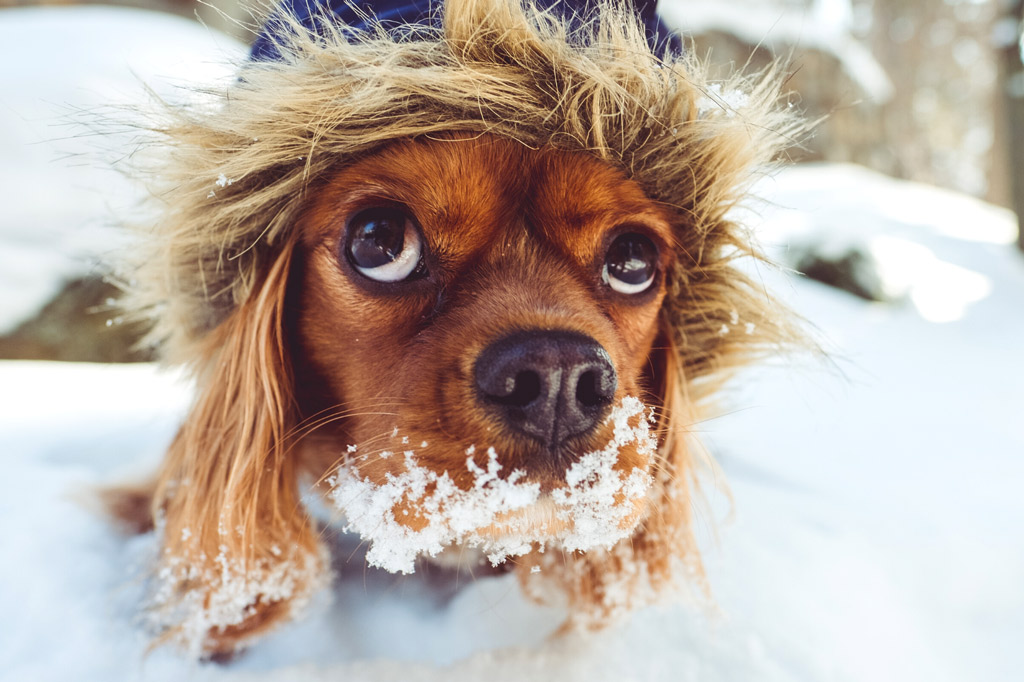
No dog parent would “intentionally” go out of their way to make their canine friend uncomfortable, and getting your dog a sweater is one of those situations where you want to know more before making a decision that might cause discomfort to your pooch.
Dog’s might look cute wearing clothes, but this leads us to fall into the appeal of humanizing our furry friends, which can have some not-so-obvious side-effects.
The first thing to discover before choosing a sweater for your pooch is…
Does your dog need a sweater?
Here are the things you can do to decide if your dog really needs a sweater and how to choose a dog sweater that is appropriate if needed!
How to Choose a Dog Sweater
Here are 7 steps to help you get a suitable sweater for your pooch:
#1 – Determine if Your Dog Needs a Sweater
The first step is to determine if your dog needs one in the first place.
Most dogs have an easy time staying warm during the winter thanks to their coats. However, there are some exceptions:
| DESCRIPTION | BREED EXAMPLES |
|---|---|
| Short-haired dogs, especially those with no double coat. | Boston Terrier, Jack Russel Terrier. |
| Skinny dogs without enough fat to keep them warm. | Greyhounds, Miniature Pinscher. |
| Short dogs with bellies that are close to the ground | Dachshund, Basset Hound. |
| Dogs with a weak immune system or medical condition like cancer, diabetes, a heart problem, or arthritis. | As described. |
| Senior dogs, which are less able to keep their body temperatures stable. | Also as described. |
If your dog has thick fur or handles the cold and rain well, then the likelihood they would need a sweater is very low!
There’s no need to make our canine friends wear a piece of clothing that does not benefit them. 🙂
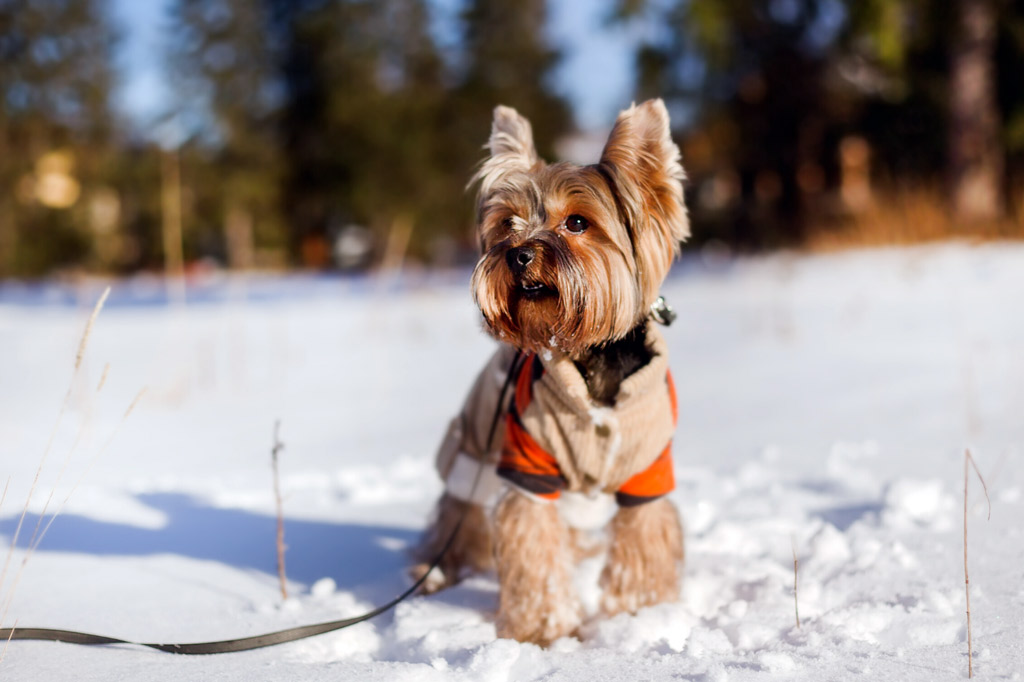
Dog clothes have gained huge attention from dog parents lately, so I think it will be useful to address the myths and facts about dogs needing clothing.
| # | MYTHS | FACTS |
|---|---|---|
| 1 | All dogs need to wear sweaters in winter. | Only those listed above might benefit from clothing. |
| 2 | All dogs can get used to wearing a coat. | Even if you introduce a sweater gradually, your dog might still not like it. And that’s totally fine. The key is not to force your pooch to wear it. |
| 3 | Large dogs don’t need sweaters. | Greyhounds, for instance, need sweaters due to their short hair and little body fat. |
| 4 | Dogs can wear a sweater for hours. | To avoid overheating your dog, only use a sweater or jacket when you take your dog outside. |
| 5 | Dogs only need a sweater in winter. | If your dog has skin allergies, as some Boston Terriers and Pugs do, a cotton sweater can help keep them from breaking into their skin, regardless of the weather. |
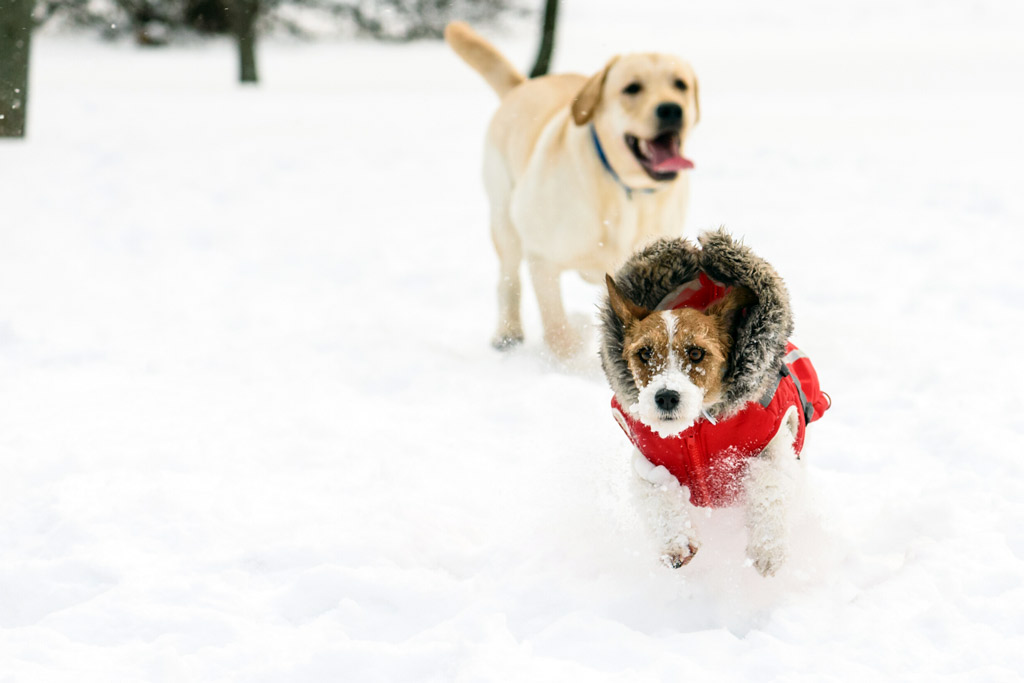
#2 – Measure Your Dog
To avoid disappointments and wasting your money on clothes that don’t fit… you should measure your furry friend first!
Insider Tip: When measuring your dog, place your dog on a flat surface, and have him stand up, looking straight ahead. It may help if another person stands in front of your pooch, so hold his attention, whilst you take the measurements.
Take a measuring tape and follow these step by step guide to measure your pooch:
- The neck circumference: Measure around the widest part of your dog’s neck snugly, but lose enough that you can fit a finger in between.
- The length of the back or spine: Measure the length of your dog’s back from the base of his neck to an inch past the dock of the tail (the beginning of his tail).
- The girth of the chest: Measure the circumference of your dog’s chest at the broadest part of his rib cage while he’s standing up and relaxed.
- The flank or waistline: How you measure your dog’s waistline will depend on if your pooch is female or male. For female dogs, measure her at the narrowest part of her waist. For male dogs, measure his waist an inch in front of his sheath.
- The breadth of the chest: Measure from the point of your dog’s shoulder on your left and span the width across your dog’s chest at the widest part.
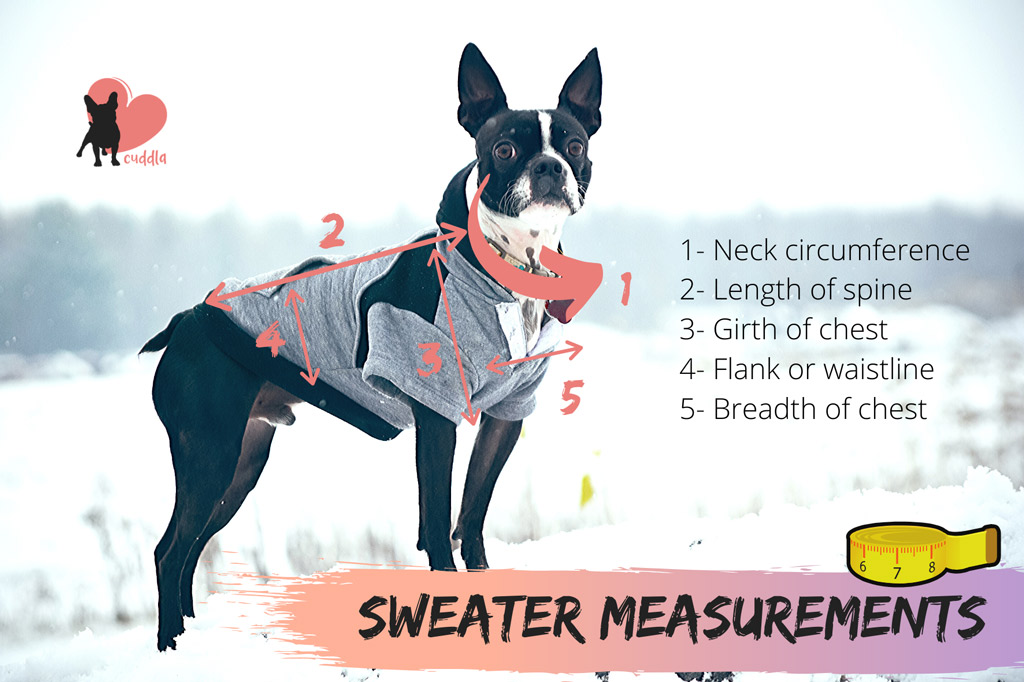
#3 – Understand What Is a Good Fit
When choosing a sweater for your furry friend, it is important that it fits properly in order for your pooch to be comfortable, look cute, and stay warm.
When clothing doesn’t fit right, your dog can:
- Suffer from restricted breathing because of the neck being too tight.
- Have restricted movement due to it being too tight on the chest.
- Get sore spots on his skin.
- Have difficulty peeing, especially for males.
If your dog is uncomfortable wearing a sweater, don’t force him. Even if it’s the right fit, your dog might not like the sweater.
To see if your doggy is comfortable wearing one, you should test it out, gradually. Start at home and try letting your pooch wear the sweater for minutes at a time. If he consistently shows discomfort or he simply “freezes in place,” scratch the idea of a sweater and move on to other things your dog likes.
P.S. Look over #5 and #7 below for the types of material and clothing to consider.
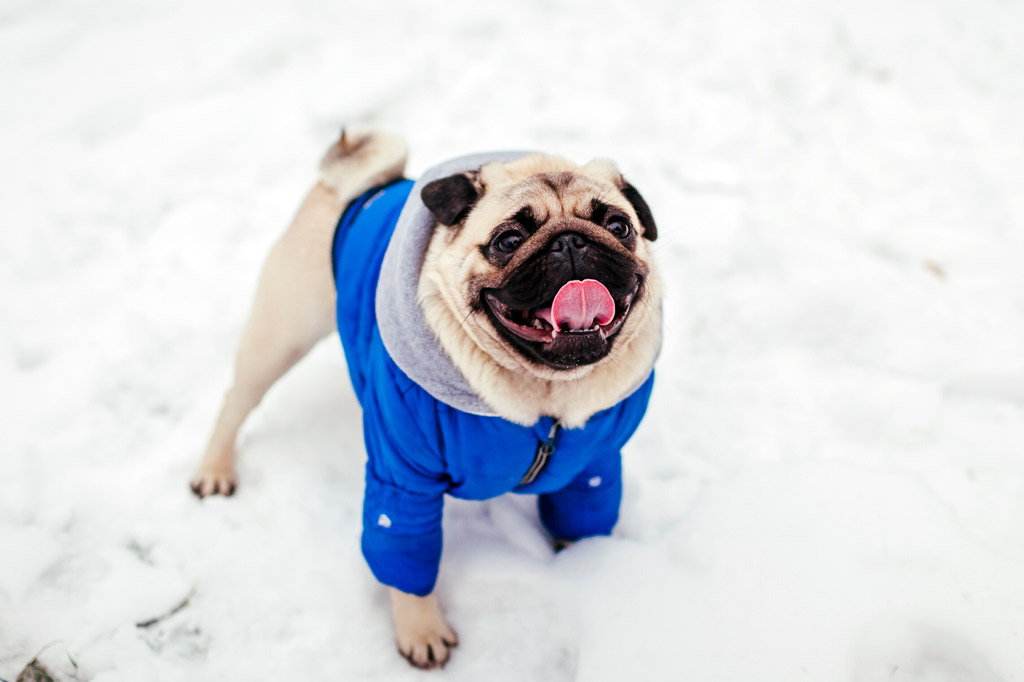
#4 – Go for Functionality and Comfort
Here are a few tips to determine is a sweater is functional and comfy:
- The sweater won’t get in the way when your dog has to go potty. For example, the sweater isn’t covering your dog’s sheath (i.e., genital area).
- The clothing item provides access to your dog’s collar or harness. Some sweaters and coats have an opening to attach your dog’s leash to his harness.
- The coat or sweater is not difficult to put on or take off. Velcro fastenings may make the process easier while jackets with sleeves can be tricky to put on and take off, especially for dogs with a varied shape (i.e., broader shoulders, thicker chest, neck or legs).
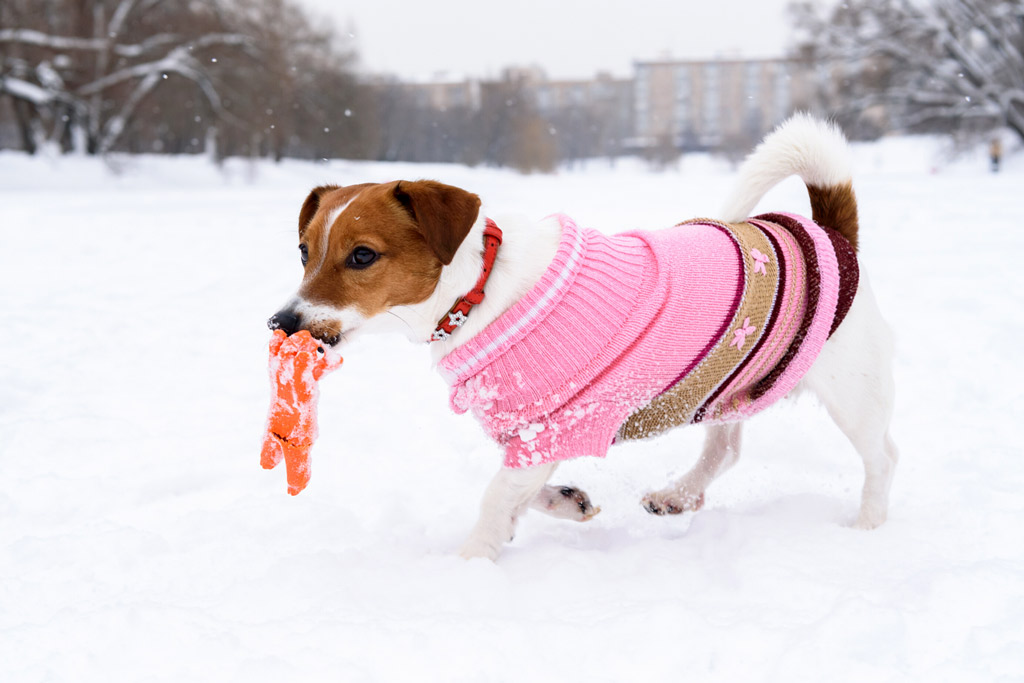
#5 – Choose an Appropriate Material
Just like we do when picking our clothing, the type of material of the garment should be considered, as it can make a huge difference:
- Wool: It’s warm but can be itchy. Plus, it may require to be hand washed.
- Acrylic and wool-blend: They provide plenty of warmth, while still being soft and easy to care for (they are machine washable).
- Waterproof and fleece layers: This is a water-resistant option that has a fleece inner layer to keep your pooch warm too.
- Cotton: A natural option to keep your dog warm.
Insider Tip: When picking the fabric for your dog’s jacket or sweater, go for an easily washed and dried option. Also, pick a material that won’t itch or irritate your dog’s skin.
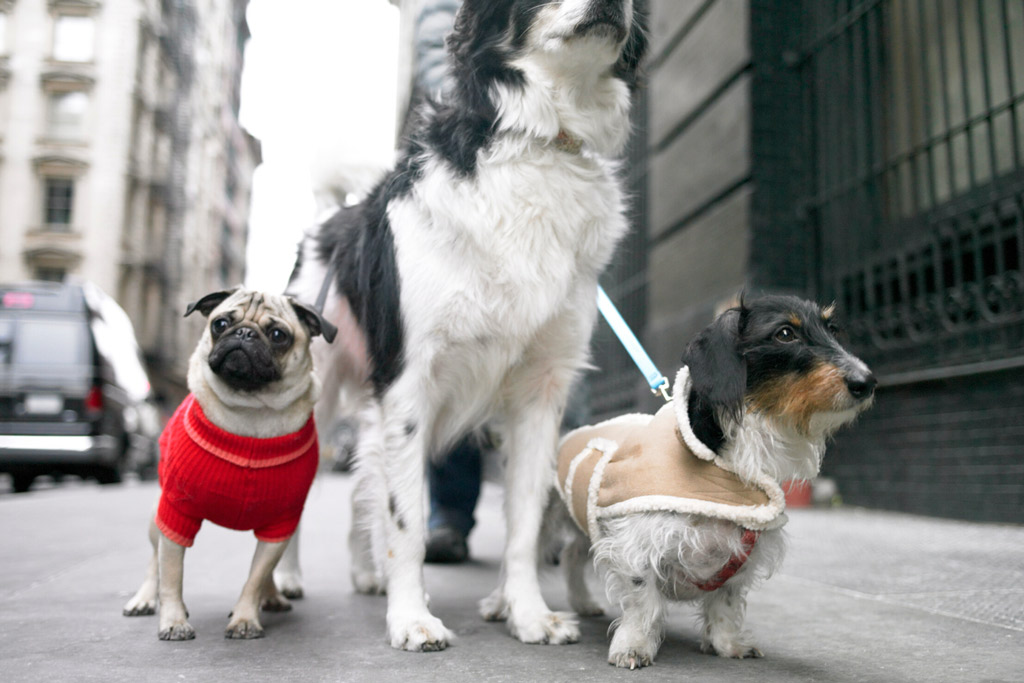
#6 – Safety is Paramount
To keep your doggy safe, choose clothes that have no pieces that can be chewed and swallowed like zippers, hooks, buttons or tags.
Also, when your pooch is wearing clothes:
- First, gradually get him used to a sweater.
- Only let him wear clothes when he’s under direct supervision.
- Remove any clothing when you are not directly observing your pooch, such as at night, whilst at work and other hours.
- Use sweaters and jackets outdoors, rather than inside the house.
But, how can you tell when to put on a sweater?
As a general rule of thumb, if it’s too cold for you, it’s probably cold for your pooch too. Temperatures lower than 32 degrees Fahrenheit (0 degrees Celcius) can cause hypothermia or frostbite.
Plus, you can also look for signs in your dog’s body language such as shivering (shaking).
Here are the signs that your dog is uncomfortably cold:
- Whining.
- Shivering.
- Appearing anxious.
- Slowing down or stopping.
- Looking for a warm place to burrow.
Note: Dogs with chronic disease, puppies and senior dogs are more vulnerable to the cold than healthy youngsters and adults.
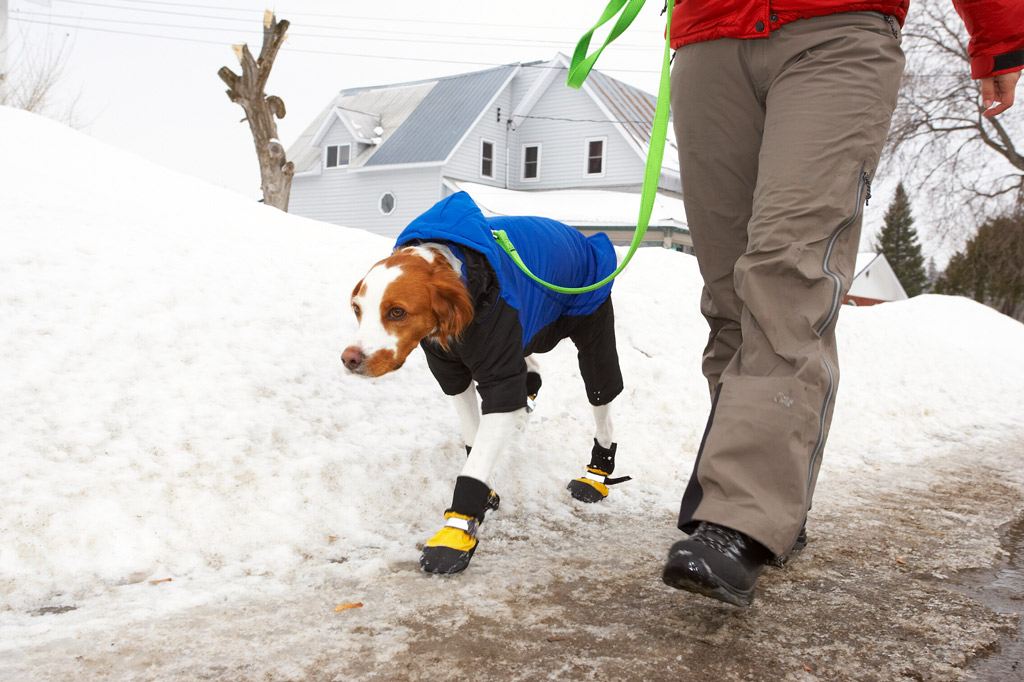
#7 – Decide What Type of Clothing Your Dog Needs
Depending on the where you live and how the weather is, there are different options to consider:
Dog Clothing
- Dog sweater: This is useful to keep your dog warm on a cold but sunny day. They don’t offer protection for wind and rain and usually have a head-hole to put them on. The different options are:
- A knit sweater.
- A fleece.
- Waterproof jacket or coat: This is to keep your dog warm whilst proofing him against the wind, rain and snow. They usually are made of a combination of materials like fleece for warmth, and polyamide so they are water-resistant. Dog jackets are the best choice for active dogs that like long winter walks or love playing in the snow. Here are some examples:
- A yellow classic poncho.
- A printed raincoat.
- A waterproof coat with fleece lining.
- Dog hoodie: It can be mostly made of cotton knitted fabric. It’s ideal for transitional seasons like spring and autumn when it’s still cold outside. A hoodie like this one provides more freedom of movement because it doesn’t stick so close to your dog’s body as dog jackets or sweaters. Also, they often don’t cover the entire back of your dog.
These are choices that you can easily shop for in Amazon. You can also browse for more options in my dog clothes list.
Dog Booties
Finally, don’t forget about the boots!
Dog booties can provide coverage and also prevent salt from getting lodged between bare pads, which causes irritation. Let your furry friend get used to booties gradually.
Although boots can be a great solution to protect your dog’s paws, you might find out that your pooch won’t want to wear them!
That’s ok, you could use natural wax instead, like Musher’s, which I find more practical.
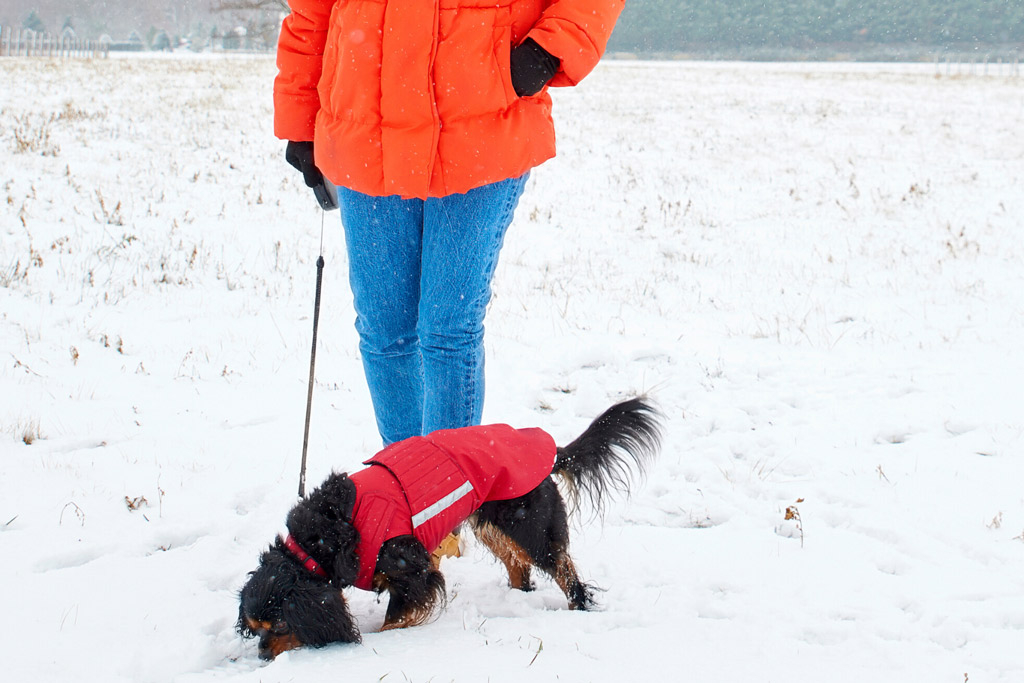
A Final Thought
Although providing for good health and a suitable environment are part of your dog’s welfare needs, animal welfare experts are warning pet owners about the risks of using clothes.
This growing trend for dog parents to clothe their furry friends is causing animals to overheat. This is due to clothing dogs that don’t need sweaters and also leaving clothing on dogs for too long.
Here’s what two experts had to say about it in an interview with Jasper Copping for The Telegraph Newspaper (source):
“Under the Animal Welfare Act, you are obliged to provide appropriate conditions and environments for your dog. So if you are slapping a great big coat on it when it really doesn’t need it, then that could cause it to suffer if it is overheating. It is the same as if you leave a dog in a car in hot weather.
Some breeds have been bred to have less fur, so in some cases it is quite appropriate for a dog to wear a coat in very cold weather. But if an owner is just doing it for a fashion statement or because they think it is cool, I would question that. If people are worried that their dog might be cold, it is worth getting some advice from their vet to see if it is appropriate or not.”
Helen Briggs, a spokeswoman from the RSPCA.
“There are very few occasions when an animal needs a coat, even in the recent cold weather.
Dogs have developed a very effective coat of their own, which will protect them from the elements. It is adjustable so they can raise the fur to control their temperature. Dressing them in a coat diminishes the animal’s ability to regulate their own body temperature and could be detrimental if the animal gets too hot.
Too high a temperature is more of a risk to the dog’s health than too low a temperature. Clothing could also rub and cause sores and if the animal is wearing it for a long time, it could cause skin conditions. Fashion-wise, coats are pointless for dogs.”
Mark Johnston, from the British Small Animal Veterinary Association.
That’s why it is important to determine if your dog needs clothing in the first place. Hope this article helped you have a better understanding of your dog’s needs when it comes to picking or using a sweater.
To add to the wealth of knowledge you now have, the next best step after this is to familiarise yourself with the Dog Care Pillars. This way you discover more about your dog’s welfare needs. 🙂

My dog, Milo, pitbull. Is he needs a sweater?
Hello Anne!
Although pit bulls might not look like the obvious candidate for sweaters… they have thin coats. Because of their short coats, they cannot tolerate extreme hot or cold weather. So, if you think Milo is cold during winter, wearing a jumper outdoors for a while won’t do him any harm!
However, see if he’s happy with it first.
Hope this helps 😉